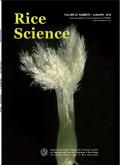重组酶辅助扩增-侧流试纸检测技术在水稻黄单胞菌疫病早期现场诊断中的应用。水稻中的稻谷
IF 6.1
2区 农林科学
Q1 AGRONOMY
引用次数: 0
摘要
白叶枯病(BB)是由水稻黄单胞菌(Xanthomonas oryzae pv)引起的一种世界性的水稻病害。这种病很难根据早期症状进行诊断。一旦BB扩散,常规的化学防治效果有限。因此,开发一种快速、高灵敏度、特异度和易于使用的检测技术对BB进行早期现场诊断势在必行。我们首先开发了一种重组酶辅助扩增-横向流动量尺(RAA-LFD)技术用于Xoo的现场检测。优化的反应温度为37℃,反应时间为20 min,表明该反应体系可由体温启动,无需任何精密仪器。利用XooORF0080基因座的引物(RAAF2/R2)和探针(raa2 - info -probe)对RAA-LFD技术进行评价,结果表明该技术具有较高的特异性,并且消除了与其他细菌的交叉反应性。RAA-LFD对Xoo基因组DNA的灵敏度可达1 pg/μL,对Xoo细胞的灵敏度可达100 CFU/mL。值得注意的是,该技术在侵染早期从人工接种和自然侵染的水稻叶片中都能准确检测到Xoo,直接利用植物组织液作为模板,无需提取DNA。这些特点使所开发的RAA-LFD系统成为现场早期诊断BB的可行技术,为预警系统和疾病控制提供技术支持。本文章由计算机程序翻译,如有差异,请以英文原文为准。
A Recombinase-Aided Amplification-Lateral Flow Dipstick Detection Technique for Early On-Site Diagnosis of Bacterial Blight Caused by Xanthomonas oryzae pv. oryzae in Rice
Bacterial blight (BB) is a devastating worldwide rice disease caused by Xanthomonas oryzae pv. oryzae (Xoo), which is difficult to diagnose based on early symptoms. Conventional chemical control yields limited effectiveness once BB has spread. Consequently, it is imperative to develop a rapid, highly sensitive, specific, and easy-to-use detection technique for early on-site diagnosis of BB. We first developed a recombinase-aided amplification-lateral flow dipstick (RAA-LFD) technique for the on-site detection of Xoo. The optimized reaction temperature and time were 37 ºC and 20 min, indicating that the reaction system can be initiated by body temperature independently of any precision instruments. Evaluation of the RAA-LFD technique using the primers (RAAF2/R2) and probe (RAA2-nfo-probe) derived from the XooORF0080 locus exhibited high specificity and eliminated cross-reactivity with other bacterial species. The sensitivity of RAA-LFD is up to 1 pg/μL for Xoo genomic DNA and 100 CFU/mL for Xoo cells. Significantly, this technique accurately detected Xoo from both artificially inoculated and naturally infected rice leaves at the early stage of infection, directly deploying plant tissue fluid as the template without DNA extraction. These attributes make the developed RAA-LFD system a viable technique for the early diagnosis of BB in the field, providing technical support for early-warning systems and disease control.
求助全文
通过发布文献求助,成功后即可免费获取论文全文。
去求助
来源期刊

Rice Science
Agricultural and Biological Sciences-Agronomy and Crop Science
CiteScore
8.90
自引率
6.20%
发文量
55
审稿时长
40 weeks
期刊介绍:
Rice Science is an international research journal sponsored by China National Rice Research Institute. It publishes original research papers, review articles, as well as short communications on all aspects of rice sciences in English language. Some of the topics that may be included in each issue are: breeding and genetics, biotechnology, germplasm resources, crop management, pest management, physiology, soil and fertilizer management, ecology, cereal chemistry and post-harvest processing.
 求助内容:
求助内容: 应助结果提醒方式:
应助结果提醒方式:


